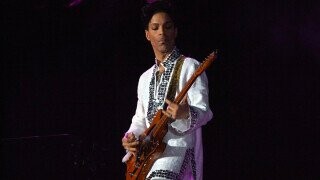Music's Journey To Electric Guitars Took Some Weird Detours

We all know the electric guitar as the quickest way to announce that you're: A) the coolest panty-droppingest cool guy on campus or B) a middle-aged dad with strong opinions on shitty beers. But the electric guitar has gone under quite a few changes over the years, starting from when it first appeared as a jank-ass frying pan. Yeah. Electric guitars have changed quite a bit.
Originally, the very first electric guitar was almost nothing like the traditional idea of an electric guitar -- it wasn't for swinging around, rocking out, or being insanely loud, it was a steel lap guitar, created because Hawaiian music was taking off and the designer wanted to capitalize on it.
Part of the issue was steel Hawaiian music worked best with small crowds, but this is America; the bigger, the better, and large crowds couldn't hear that well, so amplification was needed. The original guitar was very simple, designed as a lap guitar, to be played sitting down, instead of while screaming "Nazi punks, f**k off!"
Don't Miss
Thus was created a unique guitar, the Frying Pan.

There had been an "electric guitar" before that -- but it was merely amplified and needed to be plugged into a wall. This was the first "six-stringed solid-bodied instrument with wound pickups that utilized magnetic induction to detect changes in field flux from the string's vibration," which is apparently the clinical definition of a guitar.
George Beauchamp, who had previously worked with Adolf Rickenbaker on guitars, designed the Electro A-2 (the Frying Pan's official name) ... and then got stalled in the patent process for years, leading to a bunch of copycats, including Les Paul's first big entrance into the guitar making scheme, with a giant hunk of four by four, called the Log:

Thanks to the US Patent and Trademark Office's hold up in approving Beauchamp's guitar and the guitar's small issues, a thriving market of electric guitar makers was born.

George Beauchamp/US Patent and Trademark Office
Music was changed forever ... sorta. It took until jazz became the prominent music of the era for the guitar to really hit it big with anyone. Even then, it wasn't until Fender put out the Esquire and Broadcaster and Les Paul dropped the Gibson that the electric guitar became the instrument we know today:
But all of it ... came from this:
Has real “Stairway to Heaven” vibes.
Top Image: penner/Wiki Commons